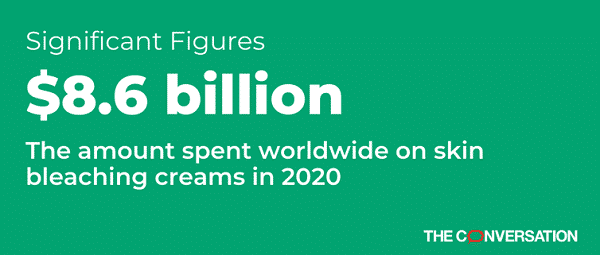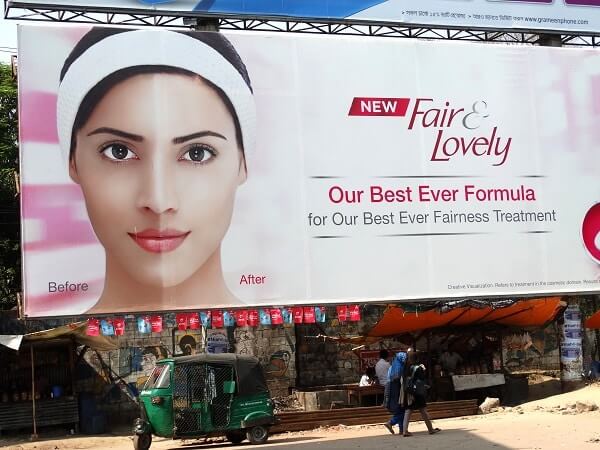The idealization of light skin as the pinnacle of beauty affects self-esteem for women of color around the world. In many cultures, skin color is a social benchmark that is often used by people of color and whites alike in lieu of race. Attractiveness, marriageability, career opportunities and socioeconomic status are directly correlated with skin color.
As a result, many women of color seek chemical remedies to lighten their complexion. They have created a booming global business in bleach creams and injectables valued at US$8.6 billion in 2020; $2.3 billion was spent in the U.S. alone. The market is projected to reach $12.3 billion by 2027.
In my work in behavioral science and colorism, I studied the phenomenon of skin bleaching during a decade of travel around the world during which I visited every major racial group – and tracked the growth of this industry. The practice has both significant racial implications and health concerns.

READ ALSO: #BlackLivesMatter
A common practice
As I stated during my interview on Oprah’s 2015 “Light Girls” documentary, while bleaching the skin is common, it’s both dangerous and potentially life-threatening because products contain steroids, hydroquinone bleach and mercury. The World Health Organization warns that skin bleaching can cause liver and kidney damage, neurological problems, cancer and, for pregnant women, stillbirth.
The practice is not new. It became popular in many African countries in the 1950s; today, about 77% of Nigerians, 27% of Senegalese and 35% of South African women bleach their skin. Indian caste-based discrimination was outlawed in 1950, but dark-skinned women (and men) are still persecuted – and fair skin remains a distinguishing social factor, associated with purity and elite status.
In the Middle East, the practice of bleaching is most common in Jordan, with 60.7% of women bleaching. The Brazilian government seems to sanction white skin over dark by encouraging immigration from Europe and discouraging persons of African descent.
Light skin is idealized in North America, but the phenomenon is contentious because bleaching is perceived as a desire to be white. So bleaching creams are marketed in the U.S. not to lighten skin, but to “erase blemishes” and “age spots.”
Their use in the U.S. spiked after the 1967 U.S. Supreme Court ruling that legalized interracial marriage.
In the aftermath of the civil rights movement, dark-complected immigrants from developing countries flocked to the U.S., carrying with them an ideal of light-skinned beauty – and they bleached their skin to attain it.
READ ALSO: Constantly learning: From #BlackLivesMatter to pandemic protests
Perpetuating ‘colorism’
Bleach cream manufacturers now face growing pressure to address racism, with activists arguing that their products perpetuate a preference for lighter skin. In 2020, Johnson & Johnson announced that it will no longer sell two products marketed to reduce dark spots that were widely used as skin lighteners.
L’Oreal, the world’s largest producer of bleach creams, pledged to remove the words “white,” “fair,” and “light” from labels – but it will still manufacture these products.
Some among African countries have moved to ban bleaching creams. The success of the blockbuster film “Black Panther” has likewise sparked a movement celebrating dark skin, with hashtags including #melaninpoppin and #blackgirlmagic.
As I see it, public education and activism on this issue must prevail to protect the health and self-esteem of women of color. The failure of either will only prolong the problem – while sustaining an $8.6 billion bleach cream beauty industry.
Professor of Social Work, Michigan State University.
This article first appeared in The Conversation. You can read it here.
READ ALSO: Embrace your difference, says Miss Universe Australia Priya Serrao
You may have noticed Indian Link news updates are no longer available on Facebook.
Here are other platforms you can find our content on and follow us:
Indian Link News website: Save our website indianlink.com.au as a bookmark.
Indian Link E-Newsletter: Subscribe to our weekly e-newsletter.
Indian Link Newspaper: Pick up up a copy at your local spice store, or click here to read the e-paper
Indian Link app: Download our app from Apple’s App Store or Google Play and subscribe to the alerts.
Twitter: Follow us at twitter.com/indian_link
Instagram: Follow us at instagram.com/indianlink
LinkedIn: Follow us at linkedin.com/IndianLinkMediaGroup
YouTube: Subscribe at youtube.com/c/IndianLinkAustralia



